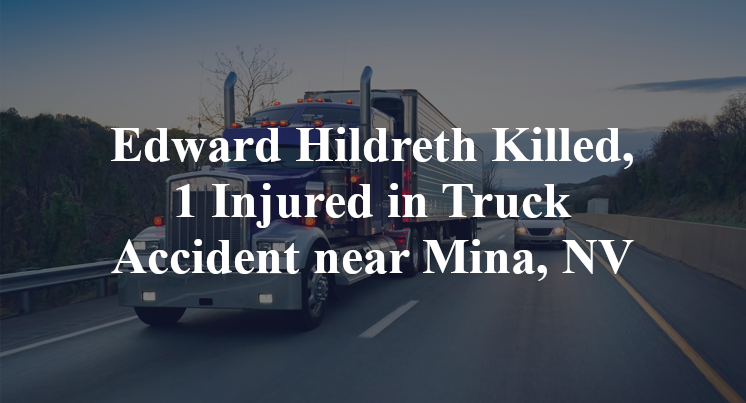Edward Hildreth Killed, 1 Injured in Truck Accident near Mina, NV
Mina, NV — June 19, 2025, Edward Hildtreth was killed and another person was injured in a truck accident shortly before 11:45 a.m. along S.H. 260.
According to authorities, two people—a driver and 86-year-old Edward Hildreth—were traveling in a northbound Chevrolet Tahoe on State Highway 360 when the accident took place.

The Tahoe was apparently traveling and lower speeds with its hazards on in the time leading up to the wreck. Officials indicate that an 18-wheeler with a refrigerated box trailer in tow attempted to pass the Tahoe on the left using the opposing lane of traffic. However, before that pass could safely be executed, the Tahoe attempted a left turn to head southbound on a dirt road. A collision consequently took place between the back-left of the Tahoe and the front-left of the 18-wheeler.
Hildreth reportedly suffered fatal injuries due to the wreck and was declared deceased at the scene. The person who had been behind the wheel of the Tahoe sustained serious injuries, as well, according to reports, and was transported to an area medical facility by EMS in order to receive necessary treatment. Additional details pertaining to this incident are not available at this point in time. The investigation is currently ongoing.
Commentary by Attorney Michael Grossman
When a truck attempts to pass a slower-moving vehicle and ends up in a fatal collision, the legal analysis hinges on who had the right to be where, and whether both drivers were acting with due caution. In this case, a refrigerated 18-wheeler tried to overtake a Tahoe that was moving slowly with hazard lights on. Before the pass could be completed, the Tahoe reportedly turned left across the truck’s path—resulting in a crash that left one person dead and another seriously injured.
It’s the kind of scenario where split-second decisions meet conflicting expectations: one vehicle trying to exit the roadway, the other trying to get around it. The outcome is tragic, but the core question is whether the crash was avoidable—and if so, by whom.
Passing on a Two-Lane Highway Comes With Risk
Passing a vehicle on a two-lane road requires absolute clarity. That includes a clear line of sight, a legal passing zone, and a firm understanding that the vehicle ahead will remain on its current path. If there's any indication that the lead vehicle might turn left—especially onto a side road—the burden is on the passing driver to hold back.
In this case, several details raise concerns:
- The Tahoe reportedly had its hazard lights on and was moving slowly. That’s a signal something unusual is happening. At the very least, it suggests caution.
- The truck initiated a pass despite that signal and speed reduction. That may indicate a failure to assess the situation fully before moving into the oncoming lane.
- The Tahoe then turned left, intersecting the truck’s path. Whether that turn was signaled—and how far in advance—will be a key point of contention.
From a legal standpoint, if the Tahoe gave a clear left-turn signal and the truck passed anyway, the truck driver may bear the bulk of the responsibility. On the other hand, if no signal was given, or if the turn came suddenly and without warning, then the analysis could shift.
Evidence Will Determine Who Had the Right of Way
To resolve these questions, investigators will need to examine:
- Turn signal usage and timing.
- Skid marks and impact angles to determine speed and position of both vehicles.
- Dash cam or witness statements to verify whether the truck driver could reasonably anticipate the turn.
I’ve worked cases where a driver began a lawful pass only to be surprised by an unsignaled turn. I’ve also seen the opposite—drivers who ignored obvious signs that the vehicle ahead was about to leave the road. The difference lies in the evidence, not the assumptions.
Key Takeaways:
- Passing another vehicle on a two-lane road requires certainty—not just about traffic conditions, but about what the lead vehicle is doing.
- Hazard lights and reduced speed may have signaled the Tahoe’s intent to turn, raising questions about whether the truck driver acted too aggressively.
- The Tahoe’s use of a turn signal and the timing of the truck’s pass attempt will be central to determining fault.
- A full investigation—including skid mark analysis, dash cam footage, and witness accounts—is essential to understand who had the right of way.
- Outcomes like this often result from misunderstandings between drivers, but that doesn’t mean responsibility is shared—only that it must be proven.

“These are essential reads for anyone dealing with the aftermath of a truck wreck”– Attorney Cory Carlson